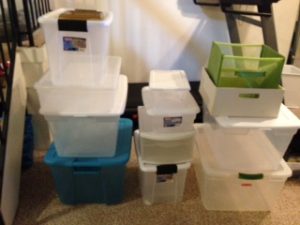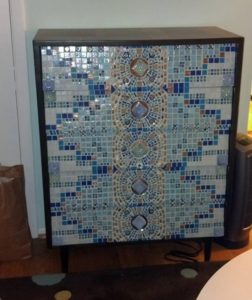 While I was going through items in a kitchen pantry with one of my clients, she commented on how easy it was to organize in the kitchen. When I asked why, she said that if food is expired it takes the decision out of her hands about whether to get rid of it or not. However, with the rest of the stuff in the home, she has to make the decision whether it has ‘expired’ or not. Deciding on the life cycle of your belongings is not easy, but when your spaces become too crowded or you can’t find your keys for the third time in one week, it’s time to take action.
While I was going through items in a kitchen pantry with one of my clients, she commented on how easy it was to organize in the kitchen. When I asked why, she said that if food is expired it takes the decision out of her hands about whether to get rid of it or not. However, with the rest of the stuff in the home, she has to make the decision whether it has ‘expired’ or not. Deciding on the life cycle of your belongings is not easy, but when your spaces become too crowded or you can’t find your keys for the third time in one week, it’s time to take action.
The life cycle concept is one way to work through the backlog of the accumulated clutter in the home and as a strategy to constantly weed out stuff. Our stuff has a life cycle that begins with it being most useful, most beautiful and most beloved. Over time our stuff becomes less useful (obsolete technology; items that wear out or break), less beautiful (fashion trends or our tastes change), and less beloved (reminders of past periods in our family’s life that may not be so important).
When you think about all of the items you bring in to your home on a weekly or monthly basis, it boggles the mind. But if you don’t take out as much as you bring in, over time you will begin to feel like your stuff is taking over. If some of your belongings are starting to become CRAP (Clutter that Robs Anyone of Pleasure), it’s time to consider whether those belongings are part of your family’s present and/or future. Keeping items from the past that no value or meaning to the present day leaves less room for additional items (or opportunities) for the future. For example, as your children grow, do you hold on to the toys they used to love, even though they don’t want them anymore?
Finally, if you are keeping items because you think they might be worth a lot of money, there are ways to find out. One way is to look on Ebay. Is anyone selling the item now? Has anyone sold that item in the last two weeks and for how much? Reputable auctioneers are also good resources for evaluating antiques and collectibles. Mass produced goods from 1960 or later have less of a chance to increase in value. But remember, regardless of what items may have been worth in the past; items are only worth what someone is willing to pay for them today.
When your clutter starts to take over your home, reevaluate whether the life cycle of those items is over or not. Someone else may be able to give your unneeded items a whole new life.
Clutter Quote: “Do not spoil what you have by desiring what you have not; remember that what you now have was once among the things you only hoped for.” Epicurus, ancient Greek philosopher
 “Eye of newt, and toe of frog,
wool of bat, and tongue of dog,
adder’s fork, and blind-worm’s sting,
lizard’s leg, and howlet’s wing…” ~William Shakespeare, Macbeth
“Eye of newt, and toe of frog,
wool of bat, and tongue of dog,
adder’s fork, and blind-worm’s sting,
lizard’s leg, and howlet’s wing…” ~William Shakespeare, Macbeth
Reaching into the cupboard for canned pumpkin, you come upon what appears to be a rotting bag of potatoes you’d forgotten that you bought a couple of months ago.
You go down to the basement to pull out your holiday décor and realize it will take days to even get close to the area where it is stored – the boxes you can reach have been chewed into by…something.
You look under a bathroom sink for the ointment you haven’t used since last year’s blister you got while raking and you discover what must be a leaking pipe (and a mass of soggy toiletries).
Just because you have not actively used a storage area for some time, doesn’t mean that it has remained unchanged in your absence. Storage spaces like basements, spare rooms, closets and cabinets can be easily ignored when organizing or cleaning. The items they contain do not present the issue of “visible” clutter. The door is closed and what is stored is not in anyone’s way. Besides, the everyday mass of new paper, gadgets and gizmos coming in that crowd our countertops are enough of a challenge. Who has the time to deal with what’s already stored? Right?
Well, unfortunately, what is out of sight and out of mind is not necessarily out of play in the functioning of our homes and lives.
We want to be able to use the storage that we have in order to be able to put away supplies, seasonal items, sentimental memorabilia and the like, so as to keep them from impinging on our daily living. However, if we continue to shove new items in, we can end up pushing older items back, back, back into the dark recesses known only to the Boogieman. Therefore, an occasional survey of storage spaces can keep them functional and friendly. And, although I doubt you’ll need worry about coming across any ingredients in Shakespeare’s brew, you may want to be prepared for the unexpected when venturing to take-on one of these areas.
If you’ve seen signs of bugs or rodents, consider bringing in an exterminator first and holding off for a week or two on the organizing. If there’s a leak that you cannot find or fix yourself, call a plumber sooner rather than later. Unaddressed leaks and critters can do damage to your health and your home, not to mention your wallet. Take care of them before they turn into a caldron full of trouble.
Let the witches and goblins that ring your bell for candy be your only scary surprise this fall season!
Click on the title above to learn more about the featured author.
 Whenever I do a workshop, I am invariably asked if you have to be born with an organizing gene. Although my answer to this question is no, I do think that all of us have gifts in different areas of life, and hence, we can all learn from each other.
Whenever I do a workshop, I am invariably asked if you have to be born with an organizing gene. Although my answer to this question is no, I do think that all of us have gifts in different areas of life, and hence, we can all learn from each other.
One of the tips that I always give my clients, workshop attendees, or anyone else who has a question about organizing is NOT to buy any containers until you see what you need. Until you know what you are going to keep after sorting and purging (this includes donating, recycling, shredding, and discarding), how would you know what size container to buy, or, if you even need one? You always want to make sure it is the right size, color, and that it will fit the space.
More often than not, there will be containers left after you’ve gone through the sorting and purging steps. You would be surprised at how many you thought you needed and bought, so use those containers first. No doubt they will work if you find you need them for other items you kept to store.
Do yourself and your wallet a favor and don’t spend the time buying something that you may not need. If you do buy something and don’t use it, are you going to remember where you put the receipt? If you find the receipt, you are going to have to spend time returning the item to the store. Wouldn’t you rather spend your time and money on what you really want?
Rather than buying the product first and then trying to see if it works for what you need, figure out your need first and then decide on the solution. When was the last time an inanimate object like a basket or plastic storage container organized you?
Click on the title above to learn more about the featured author.
 Do you enjoy spending an afternoon crafting (otherwise lovingly known to me and my friends as a Crafternoon)?
Do you enjoy spending an afternoon crafting (otherwise lovingly known to me and my friends as a Crafternoon)?
Do your materials and supplies seem to multiply like Gremlins?
Do you buy more supplies because you can’t find the ones that you already have?
Do you dread clean up time because you don’t know where to put things? Or do you avoid it all together?
The good news is that as an artist, no matter what medium you work with or how messy you can get, you have a natural love of color. Using this to your advantage is one way of helping you to set up an organized system that will work for you, and one that you will also end up loving. Continue on and see how you can teach your creative brain to love order.
Using Color to Organize
For artists who work with mosaics (my craft of choice!), jewelry, fabric and yarn, this is a great method for organizing. Artists are visual beings and the tendency is to want to see everything in front of you. Organizing by color helps to curb the need to dump everything onto your work surface, by just choosing what color you need at the time and knowing the rest of the colors are just a quick glance away.
Using Categories to Organize
For artists who paint and draw, this may be the best method for you. All colors need to be exposed to you when you work, but you can organize by medium. Acrylics, oils, charcoal, colored pencils and pastels should be kept separate. By keeping this organizational system, you can easily keep track of what’s running low. More good news is that by taking care of your materials in this way (which can be expensive, right?) you can prolong their life and avoid having to buy replacements for colors that have gone missing. Imagine being in a creative zone, only to find that you are missing what you need. Ugh!
So now that we have discussed the different ways to organize, it’s time to find storage options that will work best for you. You can think outside of the box, and you don’t need to go for the expensive predictable storage options at craft stores like Michaels. As both an organizer and an artist, my passion lies in helping people get organized and finding creative storage solutions on the cheap.
If you work with a lot of different colors and categories, a smart solution is a good old fashioned clear plastic bin. They come in a variety of shapes and sizes, yet offer the uniformity that makes for building a visually pleasing and calming organizational space. Found almost anywhere, and less expensive when bought in bulk, these beauties let you appreciate and enjoy what you have. If you are using color to organize, then let the color be the label for you. If you are using categories, create fun labels by painting ‘Acrylic Paints’ in acrylic, ‘Pastels’ in pastel, and so on, and then laminate them with an easy laminating kit that you can do at home.
Want to know how I organize my mosaics? Yes, I store some in clear plastic bins, but I also store some in a mosaic tiled dresser that I made! Yes, that’s it in the picture!
Click on the title above to learn more about the featured author.
This time of the year many of us are gearing up to head to our favorite beach house or lake cabin. While it may be hectic getting ready to go, once there, you find yourself in a relaxed, organized environment where all you have to do is enjoy each other.
Isn’t it interesting how we can live in a smaller space with less stuff while on vacation but we can’t seem to do it at home? Ok, so maybe it’s because it’s for a short period of time. Nevertheless, take a look at your hotel room, or rented house on your next vacation. Notice how they were able to find usable space within a small area. When you get home to implement some of their space saving ideas, don’t limit yourself by the design of your space.
It always helps to first sort through your belongings and purge what you don’t need (easier said than done, I know). Maybe it’s time to be tougher with yourself…”Do I really need multiple hand towels: fancy, guest, and every day?” Once you have made those culling decisions, it will become easier to see the empty space for its potential.
Look up: In most kitchen cabinets, the top half of the shelf is empty space. You can add a small wire shelf to create a second shelf. Also, tension rods make great use of vertical space under your kitchen sink to hang cleaning products.
Look behind doors: For small bathrooms with pedestal sinks, making use of a medicine cabinet can be key. Strategically-placed acrylic stick-on pods can provide additional storage. And don’t forget about repurposing a shoe organizer for behind the door. You can store everything from toiletries…to toys…to crafts!

Be creative: Just because it doesn’t look like a place to store stuff, doesn’t mean you can’t create one. For those exposed walls with studs, use hooks and hang drapery to create a closet.
So, take some tips from your next vacation. We love how rested and relaxed we feel after time away from home. There is no reason we can’t create that same type of sanctuary for ourselves year-round.

As the holidays approach, ASK before you make a single purchase:
Where will it “live”? This is probably the last question people ask… but it should be first! If you don’t want to invite clutter, make sure you know where something will be stored when not in use; otherwise, it will sit out, collect dust, and get in your way.
Why do I need this? If you’re purchasing a gift… do they really need it? Would they appreciate tickets to an event more than an object to clutter their home? Recent studies have shown that experiences give us longer-lasting JOY than material items.
Can I afford it right now? This is not just a monetary question… electronic purchases require an investment in time to set up; new phones beg for back-ups before you transfer over to a new device and don’t forget about learning curves!
What would happen if I waited? Shopping can be fun. I am the first to admit that it’s neat to re-envision your table set for the holidays, or a seasonal lift to your bedroom (I am a sucker for linens!), but your brain doesn’t know the difference between the fantasy of seeing your table set and the reality of seeing your bed made with cozy soft colorful sheets that say autumn. Go ahead and put it in your cart (be it physical or electronic)… just don’t hit “confirm purchase.” Resist placing that order. Do NOT hand over your credit card.
If you KNOW you need it, and you can afford it, but you really haven’t a clue where to put it, hire a professional organizer to help! We’re terrific at thinking outside the box, or cabinet, or fridge, or pantry, or laundry room, or bedside table or linen closet… Our list goes on for fabulous solutions to your everyday challenges.
As the holidays approach, try keeping a list of these shopping questions in your wallet or taped to your computer screen to help avoid unnecessary purchases. List the where’s and why’s in an order that makes sense to you and your purchasing patterns. This year, go into the holidays feeling in control of your spending, your space, and your holiday experiences. Your budget and your loved ones will thank you!